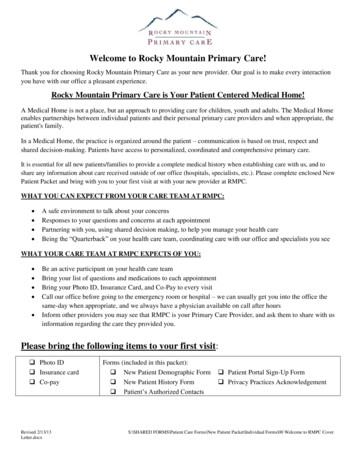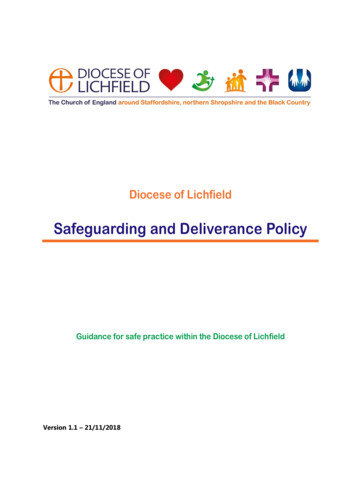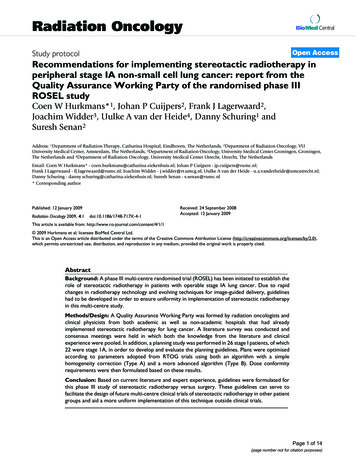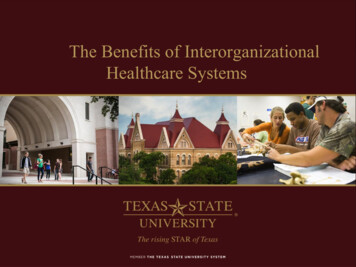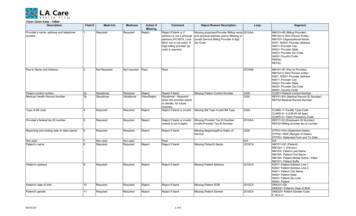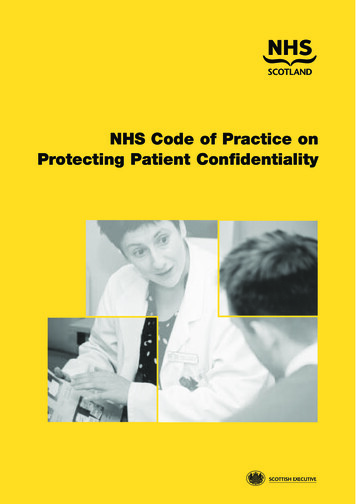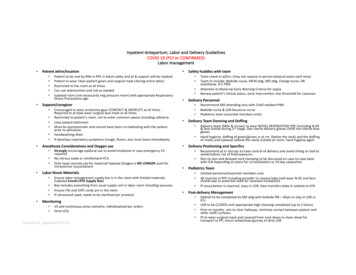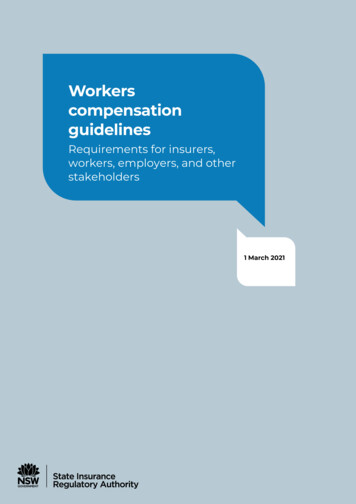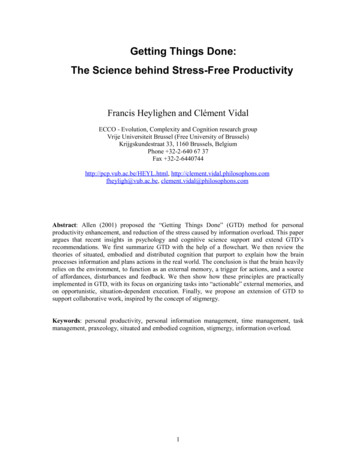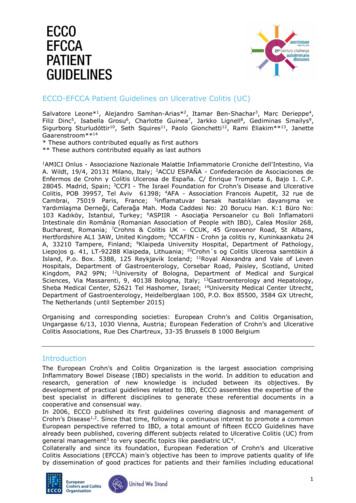
Transcription
ECCO-EFCCA Patient Guidelines on Ulcerative Colitis (UC)Salvatore Leone*1, Alejandro Samhan-Arias*2, Itamar Ben-Shachar3, Marc Derieppe4,Filiz Dinc5, Isabella Grosu6, Charlotte Guinea7, Jarkko Lignell8, Gediminas Smailys9,Sigurborg Sturludóttir10, Seth Squires11, Paolo Gionchetti12, Rami Eliakim**13, JanetteGaarenstroom**14* These authors contributed equally as first authors** These authors contributed equally as last authorsAMICI Onlus - Associazione Nazionale Malattie Infiammatorie Croniche dell'Intestino, ViaA. Wildt, 19/4, 20131 Milano, Italy; 2ACCU ESPAÑA - Confederación de Asociaciones deEnfermos de Crohn y Colitis Ulcerosa de España. C/ Enrique Trompeta 6, Bajo 1. C.P.28045. Madrid, Spain; 3CCFI - The Israel Foundation for Crohn’s Disease and UlcerativeColitis, POB 39957, Tel Aviv 61398; 4AFA - Association Francois Aupetit, 32 rue deCambrai, 75019 Paris, France; 5inflamatuvar barsak hastalıkları dayanışma veYardımlaşma Derneği, Caferağa Mah. Moda Caddesi No: 20 Borucu Han. K:1 Büro No:103 Kadıköy, Istanbul, Turkey; 6ASPIIR - Asociaţia Persoanelor cu Boli InflamatoriiIntestinale din România (Romanian Association of People with IBD), Calea Mosilor 268,Bucharest, Romania; 7Crohns & Colitis UK – CCUK, 45 Grosvenor Road, St Albans,Hertfordshire AL1 3AW, United Kingdom; 8CCAFIN - Crohn ja colitis ry, Kuninkaankatu 24A, 33210 Tampere, Finland; 9Klaipeda University Hospital, Department of Pathology,Liepojos g. 41, LT-92288 Klaipeda, Lithuania; 10Crohn s og Colitis Ulcerosa samtökin áIsland, P.o. Box. 5388, 125 Reykjavik Iceland; 11Royal Alexandra and Vale of LevenHospitals, Department of Gastroenterology, Corsebar Road, Paisley, Scotland, UnitedKingdom, PA2 9PN; 12University of Bologna, Department of Medical and SurgicalSciences, Via Massarenti, 9, 40138 Bologna, Italy; 13Gastroenterology and Hepatology,Sheba Medical Center, 52621 Tel Hashomer, Israel; 14University Medical Center Utrecht,Department of Gastroenterology, Heidelberglaan 100, P.O. Box 85500, 3584 GX Utrecht,The Netherlands (until September 2015)1Organising and corresponding societies: European Crohn’s and Colitis Organisation,Ungargasse 6/13, 1030 Vienna, Austria; European Federation of Crohn’s and UlcerativeColitis Associations, Rue Des Chartreux, 33-35 Brussels B 1000 BelgiumIntroductionThe European Crohn’s and Colitis Organization is the largest association comprisingInflammatory Bowel Disease (IBD) specialists in the world. In addition to education andresearch, generation of new knowledge is included between its objectives. Bydevelopment of practical guidelines related to IBD, ECCO assembles the expertise of thebest specialist in different disciplines to generate these referential documents in acooperative and consensual way.In 2006, ECCO published its first guidelines covering diagnosis and management ofCrohn’s Disease1,2. Since that time, following a continuous interest to promote a commonEuropean perspective referred to IBD, a total amount of fifteen ECCO Guidelines havealready been published, covering different subjects related to Ulcerative Colitis (UC) fromgeneral management3 to very specific topics like paediatric UC4.Collaterally and since its foundation, European Federation of Crohn’s and UlcerativeColitis Associations (EFCCA) main’s objective has been to improve patients quality of lifeby dissemination of good practices for patients and their families including educational1
interventions, raising public awareness, encouraging research and development of newtools for medical treatment.Through an initiative to improve the impact that consensuses on IBD have, ECCO andEFCCA have made synergistic efforts to deliver the following guidelines for patientssuffering Ulcerative Colitis.The recommendations included in this document are a collection of the most valuablestatements for diagnosis and treatment of UC. The purpose of these guidelines is toprovide a better understanding of how UC is diagnosed and treated by medicalprofessionals. The guidelines have been divided in 5 main thematic blocks related to:Diagnosis, active disease, remission, surgery, colo-rectal cancer and extra intestinalcomplications. A glossary has been located at the end of the document for a bettercomprehension of the used terminology. In addition, to achieve a higher number ofpatient readers and an easy comprehension from them, these guidelines has beenadapted in a patient’s friendly format.Diagnosis of Ulcerative Colitis (UC)How much of your colon is affected (i.e. disease extent) will help decide which treatmentyou should have. The treatment type depends on how much the disease is extended andhelps the doctor or nurse decide whether you should have oral and/or topical treatment.Disease extent affects when the surveillance of your disease should begin and how oftenit should occur. Therefore, your UC is grouped based on how much of your colon isdiseased.The preferred way to group UC is determined by endoscopy that allows confirming thedegree of inflammation in your bowel. UC can be grouped into proctitis, left-sided colitis,and extensive colitis.Experts agree that the best method to classify UC is by colonoscopy. UC should bedivided into proctitis, left-sided colitis and extensive colitis (beyond the splenic flexure).There are two broad reasons why patients with UC should be classified according todisease extent; 1. It influences the treatment type and 2. It determines the amount ofsurveillance a person receives. In terms of treatment, the first line of treatment forproctitis is often suppositories. Enemas are used for left-sided colitis and oral therapy(often combined with topical therapy) for extensive colitis.Regarding surveillance, disease extent is important for predicting who may developcolorectal cancer. Patients with proctitis do not need surveillance colonoscopy but thosewith left-sided colitis or extensive colitis do.It is useful for doctors to group UC based on how severe it is. Such grouping helps thedoctor decide the best treatment. Severity has an effect on whether the treatment shouldbe topical, systemic, surgical, or if it starts at all. Disease severity indices have not beenvalidated yet properly. Clinical, laboratory, imaging and endoscopic measures, includingbiopsies, help doctors decide what is the best treatment. The definition of remission hasnot been fully agreed upon yet. Remission is best defined using a mixture of clinicalmeasures (i.e. number of bowel motions 3 per day with no bleeding) and no signs ofdisease at endoscopy. Absence of signs of acute inflammation at biopsy is also helpful.Management of the patient is in part determined by how severe the disease is. Theseverity of the inflammation determines if the patient receives no treatment, oraltreatment, intravenous treatment or surgery. Many disease severity indices have beenproposed but none have been validated (i.e. proven to be accurate and useful) yet. It isgenerally agreed that a combination of clinical features, laboratory findings (C-reactiveprotein blood levels or Faecal Calprotectin stool tests), imaging (e.g., X-Ray,) techniques,2
and endoscopic findings (including biopsies) assist physicians in their patients'management.The definition of remission is still to be fully agreed by experts. Nowadays, the bestdefinition of remission combines the patient symptoms and the findings fromcolonoscopy. Those patients considered in remission will have three or less stools per daywith no bleeding and will have no inflammation seen on their colonoscopy. Preferably,they should also not have any microscopic inflammation in their biopsies.Symptoms of UCUC symptoms depend on how much of the colon is inflamed and how severe the diseaseis. Blood in stools, diarrhoea, rectal bleeding, tenesmus and/or needing to rush to thetoilet are the most common symptoms. UC patients also often need to open the bowelsat night-time. Feeling generally unwell, losses of appetite or fever are signs that you arehaving a severe attack.Severe UC symptoms generally coincide with severe inflammation of the colon and howmuch of the colon is affected; inflammation of the colon is measured using colonoscopyand biopsy.The most common symptom showed by UC patients is visible blood in the stools. Morethan 90% of patients report this. Patients with extensive and active UC show chronicdiarrhoea usually with rectal bleeding, or at least visible blood in the stools. Patients havealso reported urgency to pass stools, tenesmus, passing mucous or blood, the need toopen their bowels at night-time, crampy abdominal pain or ache (often the left side ofthe lower abdomen) prior to and relieved by defaecation. Moreover, if a person hassevere inflammation, they often have fever, fast heartbeat, weight-loss, abdominalswelling or reduced bowel sounds. In contrast, patients with proctitis usually reportrectal bleeding, urgency, tenesmus, and occasionally severe constipation.Patient historyA full medical history should include many questions. For example, the doctor should askabout when the symptoms began and which type of symptoms. Such symptoms include:blood in stoolsurgencystool consistency and frequencytenesmusabdominal painlack of bowel controlneeding to go to the toilet at night-timesome symptoms not directly related to the bowels (e.g., joint pain).The doctor should also ask about:recent travelcontact with infectious illnesses that can affect the bowelsmedication (e.g., antibiotics and NSAIDs)smoking habitssexual practicehaving a family member with CD, UC, or bowel cancerprevious appendectomy.The diagnosis of UC should be suspected from clinical symptoms, such as blood in stool,urgency, frequency, tenesmus, abdominal pain, lack of bowel control, and needing to goto the toilet at night-time. The doctor or nurse should enquire about the family history ofboth IBD and bowel cancer. The patient should be asked about eye, mouth, joint or skin3
symptoms. Infectious (e.g. bacteria from overseas travel) or drug induced (e.g. NSAIDslike ibuprofen) colitis need to be considered and excluded.Appendectomy for confirmed appendicitis has been shown to decrease the risk of gettingUC later in life. It also makes the UC less severe if performed for ‘true’ appendicitis at ayounger age.If you have a family member with CD or UC, you are higher risk to get UC yourself.Studies have shown that in case a person had an appendectomy for confirmedappendicitis at an early age they are less likely to get UC; this risk reduction is reportedto be as high as 69%. In addition, if you get UC after an appendectomy, it is less likely tobe severe. It should be noted that appendectomy does not prevent the development ofPSC. It is currently unknown if appendectomy after developing UC affects the diseasecourse.First degree relatives of people with UC are 10-15 times more likely to develop UCthemselves. However, because the risk is so low to begin with, a first degree relative hasa 2% increased risk of developing UC. Therefore this increased risk should not besignificantly influential on a patient with UC deciding whether or not to have children.Physical examinationA physical check-up should include a range of things:general well-beingheart ratebody temperatureblood pressureweightheightabdominal exam for swelling and sorenessano-rectal examinationWhen a doctor or nurse carries out a physical examination, findings will depend on howsevere the UC is and the extension of the disease. If a person has mild or moderatedisease activity, their examination will usually not reveal much apart from blood from theano-rectal examination. If a person has severe inflammation, they may have a fever, fastheart rate, weight-loss, tenderness in their colon, abdominal swelling, or reduced bowelsounds.Diagnostic testsEarly tests should include a full blood count, serum urea, creatinine, electrolytes, liverenzymes, Vitamin D levels, iron studies, and CRP. Faecal calprotectin is an accuratemarker of presence of inflammation in the colon. CRP and ESR are useful for measuringthe response to treatment in severe disease. The doctor should test for infectiousdiarrhoea, including Clostridium difficile. The doctor should find out whether the patienthas been immunized against many viral diseases or has tuberculosis.Ideally at diagnosis, every patient should have a full blood count, inflammatory markers(CRP or ESR), electrolytes, liver function tests, and stool sample tests carried out. Faecalcalprotectin, obtained by a stool test, will accurately measure whether there isinflammation in the colon. However, tests measuring inflammation may be normal in mildor moderate left-sided UC. The full blood count may reveal (a) high platelet levels as aresult of persistent inflammation, (b) Anemia and low iron levels indicating diseasechronicity or severity, and (c) increased white blood cell count raising the possibility ofinfection being present.4
Other than proctitis, CRP levels tend to be higher when a patient has severe symptoms.A high CRP level will usually coincide with high ESR, lower iron, and low albumin levels.These markers can also be used to see whether a person with acute severe colitis needssurgery. When raised, CRP and ESR can also represent the presence of infection. Thismeans that they should not be used alone for distinguishing UC from other causes ofsymptoms. Therefore, the doctor or nurse should also rule out other possible causes,such as bacteria (e.g. Clostridium difficile, Campylobacter, or E. coli) or parasites (e.g.amoebae).ColonoscopyWhen UC is suspected, colonoscopy (preferably with ileoscopy) and biopsies in manyplaces in the bowel (including the rectum) are the best methods to confirm diagnosis andseverity. In case of a severe attack, abdominal X-rays should be performed and activedisease confirmed by sigmoidoscopy as a first line method.Immediate admission to hospital is warranted for all patients fulfilling criteria for severecolitis to prevent delayed decision making, which may lead to increased perioperativemorbidity and mortality.Colonoscopy with intubation into the small bowel, along with many biopsies is the bestmethod to confirm a suspected diagnosis of UC. This allows the doctor or nurse toobserve more of the colon and may be more effective than a sigmoidoscopy. However,the availability of resources as well as the severity of the suspected disease needs to beconsidered. Colonoscopy and bowel preparation should be avoided in patients with severecolitis because of the potential loss of time and the risk of perforation of the colon.When a patient with suspected UC has severe disease, a plain abdominal radiography canbe initially used, although it does not guarantee a diagnosis. Sigmoidoscopy as opposedto colonoscopy can then be used to confirm this.If UC is inactive, findings at endoscopy can help predict the futureRepetition of the endoscopy is useful if and when UC becomes activeuseful if the patient needs to take steroids to stay in remission orremission even when taking steroids. Lastly, endoscopy is usefulconsidered.of the disease.again. It is alsocannot get intoif colectomy isStudies have shown that in case there is no sign of inflammation during the colonoscopy,a patient is less likely to relapse or need colectomy in the future. They are also morelikely to be symptom free for the year following the colonoscopy. Disease location,determined using colonoscopy, is also important for predicting future outcomes,assessing the risk of cancer, and determining what treatment should be applied.However, despite the apparent/seeming importance of colonoscopy for determiningdisease location, there has never been a study investigating routine colonoscopies afterthe initial colonoscopy at diagnosis.In presence of stenosis (i.e. narrowing) of the colon, the doctor should rule out cancer asthe cause of it. Many biopsies should be taken from the colon and surgery can beconsidered. Sometimes endoscopic intubation of the whole colon is not possible. In thesecases, imaging procedures, such as double contrast barium enema, or colonography maybe used.In longstanding Ulcerative Colitis, a colonic stenosis (i.e. stricture/narrowing) is apotential sign of a bowel cancer tumour and requires careful assessment using5
colonoscopy and biopsies. If colonoscopy is incomplete due to a stenosis, double or singlecontrast barium enema can be used to assess the narrowing and the colon adjacent to it.CT colonography can assess the tissue pattern near to a colonic stenosis, as well asextra-intestinal (i.e. tissue that is not in the intestine) pathology and is thereforebecoming the investigation of choice in this situation.The term indeterminate colitis (IC) should only be used for resection samples. If thedoctor does not know whether you have CD or UC after all possible tests have beendone, then it should be called IBD unclassified (IBDU).IBD unclassified is the term best suited for cases where a definitive distinction betweenUlcerative Colitis, Crohn’s Disease, or other causes of colitis cannot be made. This term isapplied when the distinction cannot be made even after the medical history, endoscopicappearance, histopathology of multiple mucosal biopsies and appropriate radiology havebeen taken into account. Indeterminate colitis is a term reserved for pathologists todescribe a colectomy sample which has overlapping features of UC and CD.Medical therapy of active Ulcerative ColitisProctitis5-ASA 1g suppository once per day is the preferred early treatment for mild or moderateproctitis. 5-ASA foam enemas can also be used. Suppositories may get more of the drugto the rectum and patients seem to prefer them over enemas. Combining topical 5-ASAwith oral 5-ASA or a topical steroid is better at treating the disease than either alone.Oral 5-ASA alone is not as good as combined for treating the disease. More resistantproctitis may need treatment with immunosuppressants and/or anti-TNFs.If a person has proctitis, topical 5-ASA is the best treatment; this has been demonstratedin numerous studies which reported 5-ASA reducing symptoms and improving thefindings in colonoscopy and biopsy. In addition, suppositories are more effective thanenemas as they target the site of inflammation and are detected in the rectum of morepatients after 4 hours (40% versus 10%). No increase in effectiveness of 5-ASA is foundbeyond one gram per day and having it once per day is as effective as many times perday.Multiple studies have shown topical mesalazine is more effective than topical steroids interms of reducing symptoms as well as improving the findings in colonoscopy and biopsy.Topical steroids should be reserved to people who are intolerant to topical 5-ASA.Topical 5-ASA is more effective than oral 5-ASA alone for proctitis. Combining topical andoral 5-ASA, meanwhile, seems to be more effective than either alone, in case the patienthas disease extending less than 50cm from the anal verge. Combining topical 5-ASA withtopical steroids also helps. If the combination of oral or topical 5-ASA with topicalcorticosteroids does not successfully treat it, oral prednisolone should be added. If allelse fails, immunosuppressant or anti-TNF treatment should be used.Left sided colitisEarly in treatment, active mild-moderate left-sided colitis should be treated with 1g of anaminosalicylate enema per day combined with more than 2,4g of oral mesalazine perday. Combined treatment with oral plus topical 5-ASA treatment is better than usingtopical steroids or aminosalicylates alone. It is also better than oral aminosalycilatesalone. Topical 5-ASA is better at treating the disease than topical steroids. Taking 5-ASAdoses once daily is just as good as taking 5-ASA in divided doses. Systemic6
corticosteroids can be used if 5-ASA does not work. When the disease is severe then thepatient should be admitted to the hospital for intensive treatment.There is clear evidence from studies that both oral and topical 5-ASA are effective forleft-sided UC. Therefore, first line treatment for mild to moderately active left sided colitisis combined oral and topical 5-ASA; it is shown to be more effective than either appliedseparately combining oral and topical treatment is both more effective and works quickerthan either alone. Results from multiple studies have shown rectal 5-ASA to be moreeffective than rectal corticosteroids, although several studies have shown that rectalbeclomethasone dipropionate (a steroid medication) is as effective as rectal 5-ASA.Several studies have shown that there is no advantage to divide the dose and so 5-ASAscan be taken once daily. However, increasing the dose has been shown to lead to betteroutcomes for patients and the minimum recommended dose for left-sided colitis is 2.4grams per day.Sometimes when 5-ASA is not effective or tolerated well in patients with left-sided UC,oral corticosteroids should be considered. Oral steroids may work more quickly but havethe potential to cause more side effects. 5-ASAs take an average of 9-16 days to workand response will be more rapid with combination treatment, compared to oral treatmentalone. If a patient on 5-ASA deteriorates in terms of symptoms, has rectal bleedingbeyond 10-14 days of commencing treatment, or does not have relief from all symptomswithin 40 days, additional therapy (usually oral corticosteroids) should be started.Extensive colitisEarly in treatment, extensive colitis of mild-moderate severity should be treated withmore than 2,4g of oral 5-ASA per day. This should be combined with topical 5-ASA, iftolerated, to increase the chance to stay in remission. Taking 5-ASA doses once daily isjust as good as taking 5-ASA in divided doses. Systemic corticosteroids should be given ifone does not respond to 5-ASA. Severe Extensive colitis needs hospitalization forintensive treatment.Oral 5-ASA is effective for the induction of remission of mild to moderately activeextensive UC. In addition, the combination of oral and topical 5-ASA is more effectivethan oral 5-ASA alone; a clinical trial showed combined treatment to achieve remission in64% of patients compared to 43% who were taking oral 5-ASA alone. Once daily 5-ASAis as effective as divided doses in patients with extensive colitis.Oral steroids should be started if mild or moderately active disease does not respond to5-ASA. Similarly, if a patient is already on more than 2 grams per day of 5-ASA orimmunomodulators as maintenance therapy and has a relapse, they should startsteroids. Steroids have been shown to be valuable in inducing remission in at least twostudies. If a person has severe extensive UC, they should be hospitalized because this ispotentially life-threatening condition.Severe colitisIn the presence of bloody diarrhoea, more than six times per day and any signs ofsystemic toxicity (i.e. a heartbeat of more than 90 beats per minute, a fever of morethan 37.8oC, haemoglobin levels of less than 10.5g/dL, or an ESR more than 30mm/hr ora CRP level higher than 30mg/l), the patient has severe UC and should be admitted tohospital for intensive treatment.Around one in every six UC patients has a severe flare at some point in their diseasecourse. Severe UC needs to be treated seriously. Despite advances made in treatment inthe past century, 2.9% of patients admitted in the UK with acute severe UC die although7
less than 1% will die in specialist centres. Due to the risk of death from severe UC, it isimportant to recognise when a severe flare is happening. A severe UC flare is happeningwhen the patient has six or more bloody stools per day in addition to one of thefollowing: (a) a fast heartbeat (more than 90 beats per minute), (b) fever, (c) anaemia,or (d) high ESR or CRP levels.All patients who are having a severe flare need to be admitted to hospital for intensivetreatment that will initially include IV corticosteroids and then graduate to ciclosporin,tacrolimus, or infliximab if the patient does not respond to the IV corticosteroids withinthree days. In cases where the patient does not respond to medical treatment, they willrequire surgery. Decisions regarding high intensity medical treatment and surgery needto be made quickly but also carefully. If surgery is delayed too long, more complicationsduring surgery can occur.Severe active UC should be treated with IV steroids. One can use IV ciclosporin by itself.Low molecular weight heparin should be given to reduce the risk of blood clots. A jointteam of a gastroenterologist and colorectal surgeon should take care of the patient.The response to IV steroids is best assessed using medical tests around the third day. Incase of severely active UC not responding to IV steroids, other treatment options shouldbe discussed, including surgery. Ciclosporin, or infliximab or tacrolimus may be suitableas second line treatment. If there is no improvement within 4-7 days of salvage therapy,colectomy is recommended.Deciding when to recommend/advise colectomy to a UC patient is one of the mostdifficult decisions that a gastroenterologist has to make. However, the gastroenterologistin collaboration with the surgeon needs to be as decisive as possible and not have theirjudgment clouded by the patient’s understandable reluctance to delay surgery. If surgeryis delayed too long, this can increase the chances of complications or even death duringcolectomy.Objective measures (i.e. measures not influenced by the emotions of the patient ordoctor) are needed to aid the gastroenterologist in important decision making regardingwhether to treat the severe UC with colectomy or medications such as ciclosporin,infliximab or tacrolimus. Clinical (e.g. high stool frequency), biochemical (e.g. high CRPlevels), and radiological (e.g. colonic dilatation) markers are objective measures that canbe used to assist in the decision making process. It is also important to consider thepatient’s individual circumstances when making a decision. For example, intravenousciclosporin should be avoided in patients with low cholesterol or magnesium due to theincreased risk of neurological side effects in this patient group.Medical treatment to maintain remissionThe choice of maintenance treatment is informed by many factors:how much of the bowel is diseased (i.e. disease extent)how often flares occurwhether prior maintenance treatment failedhow severe the most recent flare waswhat treatment was used to gain remission during the most recent flarethe safety of maintenance treatmentcancer prevention.Selection of the right treatment to keep patients in remission depends on a range offactors. Those patients with proctitis are more likely to only need topical treatment8
whereas those with left-sided or extensive UC will require oral therapy. Moreover, if aperson has a history of short periods between flares, they will benefit more from moreintense therapy because this may increase the time between flares. If a medication hasnot worked for maintenance in the past, it should not be tried again. If a recent flare wasmore severe, more intense therapy should be undertaken. Severity of a present flare willpredict the likelihood of a future flare. If a patient needs steroids to gain remission, theyare more likely to need an intensive therapy to maintain remission. Side effects of themedications should be weighed up with their benefits in terms of flare and cancerprevention.Amino salicylic acidOral 5-ASAs are the first line maintenance treatment if patients respond to 5-ASA orsteroids (oral or rectal). Rectal 5-ASA is the first line maintenance treatment for proctitisand can be used for left-sided colitis. Oral and rectal 5-ASA combined can be used as asecond line maintenance treatment.Many studies have demonstrated that oral 5-ASAs are effective for maintainingremission. In addition, two studies have reported the use of rectal 5-ASA to successfullymaintain remission in those patients with left-sided UC. Treatment with both oral 5-ASAand 5-ASA enemas has been shown to be more effective than oral 5-ASA alone formaintaining remission. A survey of UK patients reported that 80% preferred oraltreatment alone; so it seems that oral treatment is more acceptable to patients thanrectal treatment.Oral 5-ASA does not work below a dose of 1.2g per day. For rectal treatment, 3g perweek in divided doses is enough to maintain remission. The dose can be altered/changedbased on how much it works. In some cases higher doses with or without topical 5-ASAare useful. You will not have more side effects from taking 5-ASA once daily. Other oral5-ASA medicines are preferred over sulfasalazine (even though sulfasalazine may beslightly more effective) because they have fewer side effects. All available oral 5-ASAsare effective. There is no strong evidence that any 5-ASA is better than the others formaintenance treatment.The minimum effective dose for oral 5-ASA is 1.2 g per day. Considering that there is noincrease in side effects with higher doses of 5-ASA, higher doses should be given incertain cases. It also makes no difference whether you take the 5-ASA once per day orseveral times per day. Once per day is preferred because it improves adherence. Whileoral 5-ASAs have comparable effectiveness to sulfasalazine, 5-ASAs are preferredbecause they cause fewer side effects. Overall, there is no strong evidence that anyparticular 5-ASA is the better than the others.Long term 5-ASA maintenance treatment is recommended because it may reduce the riskof getting bowel cancer.A study has shown that regular 5-ASA treatment reduces the risk of getting bowel cancerby 75%. Therefore, it should be seriously considered as a maintenance treatment.ThiopurinesIf steroids are needed to stay in remission, the patient should be treated with athiopurine.Azathioprine is more effective than 5-ASA for reducing symptoms and inflammation (asseen in colonoscopy) in patients who need steroids to stay in remission. Moreover, about9
half of steroid dependent patients on azathioprine
suffering Ulcerative Colitis. The recommendations included in this document are a collection of the most valuable statements for diagnosis and treatment of UC. The purpose of these guidelines is to provide a better understanding of how UC is diagnosed and treated by medical professionals. The guidelines have been divided in 5 main thematic .
